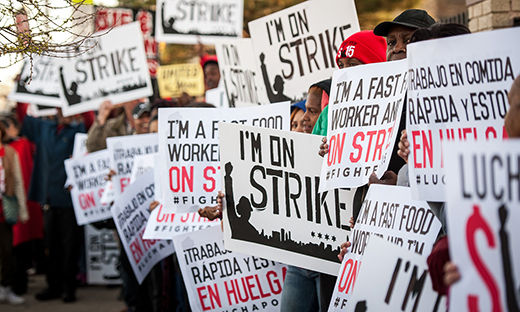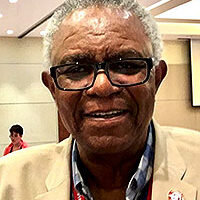
NEW YORK – My first job after graduating West Philadelphia High in January, 1959 paid $1.00 an hour. It had no union, no benefits; no sick leave and no vacation time.
After 40 hours they had to pay me $1.50 an hour. That was the law. I worked six days a week, eight hours a day, Monday to Friday and was paid $1.50 an hour for eight hours on Saturday.
I grossed $52.00 a week. I was 17 and still living at home. After taxes, carfare and lunch I was able to contribute $10 dollars a week at home and have a little left over for a very modest social life. At age 17 a good social life meant everything but six days a week of physical labor for minimum wage didn’t give me much energy or money to have a real social life.
I had to have a job. I’d been looking for work for months. High unemployment among black youth was real. I could not afford to turn down a job, not even a minimum wage job.
But the boss had a different class perspective. The most discouraging and insulting thing that was said to me by the owner of the company when he hired me was, “If you work hard and keep your nose clean, this could be a life-time job.”
Like all youth, I had hopes and dreams for a better life. I was willing to start there but not be stuck in a dead-end job for the rest of my life.
Fast forward 56 years and I am among the 20,000 in New York City who are marching down Broadway. I am proudly carrying the banner of the New York District of the CPUSA with a group of comrades and friends. I’m part of this historic nationwide march and strike for a $15.00 minimum wage and the right of the working poor to unionize.
While marching I’m thinking about how it was then and how it is now. If the kind of movement I saw on the streets of Mid-town Manhattan had been around in Philadelphia in 1959 I would not have hesitated to join.
I’m surrounded by thousands of enthusiastic, majority black, Latino, and white working- class people. There are huge numbers of young people – young families pushing baby strollers with their kids on their shoulders, waving flags and carrying signs. What a beautiful sight. They are marching, chanting and waving beautiful placards.
There were large contingents from some of the most powerful unions in this country marching side by side with young non-union low-paid workers who understand that their hopes and dreams can be realized by organizing and becoming a part of the trade union movement. The union members understand that in order to fight for their future they need the energy, militancy and fighting spirit of the low wage workers.
This is a sweet coalition that can make great change. That is why there was a spirit of optimism in this march. You could see it in the workers who came out of the hotels, theaters, and retail shops and cheered us on and danced to the beat of the marching band for the Louis Pink Houses (Public Housing Project) where unarmed, 28 year-old, Ikai Gurly was shot down by a nervous NYPD rookie.
Yes there are some signs and shirts with “Black lives Matter” and “All lives Matter.” This working class march unites the fight for economic justice with the fight for racial justice.
That is the winning political combination.
As I said, you could feel the optimism in this march. The large numbers, the racial and gender diversity, union and non union, and the winning combination were all there.
You could feel the optimism and confidence too which many of the speakers expressed: “This fight can be won.”
Those who marched with our banner were so impressed with how happy and warm people were in the march and on the sidelines.
Mike the retired transit worker talked about his first paycheck and how low the pay was for a young worker even a worker with a union.
Jackie, a woman and a former steelworker, said, “This is so wonderful, marching with the salt of the earth.”
We talked we chanted, we waved our banner and signs. We where with Estevan, Emerson, Gabe, Tina, Sara and her student friends. We must have marched 25-30 blocks dodging pot holes and construction barriers but it was so uplifting that most of the time I did not feel my aching feet.
This was the beautiful mosaic of our working class giving leadership and direction to people whose rights have been beaten and battered and suppressed under the heel of the arrogant 1 percent. In 200 cities, 60,000 marched. Quantitatively, this march was not the largest march we have seen, but qualitatively, Apr. 15 was politically a really big deal.
April 15, 2015 was more than the usual day of demonstrations. It was certainly more than tax day.
It was a turning point in the unity, politics and organization of the movement to end inequality. This is the movement that is pushing forward, that is strategically fighting back against the tyranny of the extreme right wing political minority. This march said the $15 minimum wage can be won and more. It said that the U.S. labor movement is still a strategic life force and can and will play its leading role in today’s urgent fight for democracy.
This movement is another example of the changing tactics and strategy of organized labor. Mary Kay Henry, president of SEIU, as reported in the NY Times, pointed out that supporting unorganized low-paid service workers was a result of a calculation that the 20th Century model of organizing workers was rapidly becoming obsolete for those in a growing sector where employers considered it essentially costless to replace them.
“We can no longer change our lives and our kids lives, without the support of a broader movement of workers,” she added.
When seen in relationship to the great movement against climate change, the fight against racism and police murders, all of which had some expression at the march on April 15, this is a very dynamic era of struggle we are living through. Great dangers exist, of course, but there are also great possibilities.
April 15th shows that this nation, politically drawn and quartered by the haters, strapped down and tortured on the wheel of war, corporate greed, racism and inequality not only must, but shall overcome. The multi-racial working class with its organized sector, along with its many willing and active allies, is decisive.
This march, as part of this dynamic era of political upsurge, calls for all of us to step up the fight for a $15 minimum wage – to build a mighty fortress for justice.
Photo: Fightfor15.org










